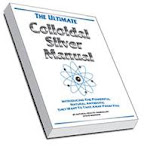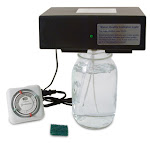Leg ulcers are one of the most painful
and problematic of medical issues.
They’re described in the medical literature as “wounds, injuries or open
sores on the legs that will not heal or that keep returning, and that may
become severely infected.”
While leg ulcers often start out as
small cuts or wounds, healing can be exacerbated by a variety of factors
including diabetes, poor circulation of blood in the veins, arterial disease,
kidney failure, high blood pressure, fluid buildup, inflammatory disease, and
more. When that happens, the wound
refuses to heal, and instead, gets worse.
Indeed, chronic leg ulcers can (and
often do) become infected by bacteria, often resulting in green, foul-smelling
discharge from the ulcer site and red swollen skin around the ulcer itself that
in severe cases might even turn brown or black from infection.
But here’s the good news: It’s been known since 400 years before Christ
that silver helps heal ulcerations of the skin – including leg ulcers – often stopping
infections in their tracks and even helping the wounds heal, close up and disappear.
Here’s the straight scoop you won’t
find anywhere else…
Hi, Steve
Barwick here, for The Silver Edge…
Hippocrates,
the “Father of Medicine,” taught that silver aided skin and tissue repair. Indeed, around 400 B.C. in his treatise “On
Ulcers,” he listed silver, in powder form, as a primary treatment for ulcerations
of the skin.
Likewise,
Pliny, the Elder, in his great work, Natural History (78 A.D.), reported in
Book II, Section XXXV, that the “residue of silver... has healing properties as
an ingredient in plasters, being extremely effective in causing wounds to close
up..."
But let’s
leap ahead to more modern times:
In a
Scandinavian study conducted in 1963 titled
“Preoperative Treatment of Leg Ulcers with Silver Spray and Aluminum Foil,”
researcher Knut Haeger wrote about treating infected leg ulcers with “colloidal
silver spray.” He stated:
“Sixteen
patients with leg ulcers were treated with a colloidal silver spray. The
solution was applied once daily for the first few days, then twice weekly. The
infection subsided in all cases.
After
instruction, patients performed the therapy at home without supervision. No
discomfort or side effects were observed. There was no persistent discoloration
of the skin that could be attributed to silver. In all cases the infection subsided.”
In
a 1977 study, titled “A
Trial of Silver-Zinc-Allantoinate in the Treatment of Leg Ulcers,” long-time antimicrobial
silver researcher Harry W. Margraf, Ph.D., and Thomas H. Covey, Jr., M.D.,
discovered that silver and zinc incorporated into an ointment worked wonders
for leg ulcers. They wrote:
“Three
hundred thirty-nine of 400 chronic cutaneous ulcers in 264 patients
(including some with multiple or bilateral ulcers or both) were healed with
silver-zinc-allantoinate cream (AZAC 1%).
Some of the
patients treated had failed to respond to medicated wrappings, saline
dressings, and various other therapeutic agents, including antibiotics.
In one week
of treatment with AZAC 1%, bacterial counts were reduced on the average from
approximately 2 × 107 to 2 × 105 [i.e., 99%
reduction].
Silver-zinc-allantoinate
cream also demonstrated a wide spectrum of antimicrobial activity. It did not
give rise to resistance by the infecting organisms, was nonallergenic, debrided
necrotic tissue, and stimulated healthy granulation.
Treatment was
well tolerated, side effects being limited to a burning sensation in three
patients. Most patients cared for themselves at home with minimal
interference in their usual daily activities.”
And
in another study, published
in the French journal Phelbologie in
December 1989, a prescription silver-based cream known as silver sulfadiazine (normally
used for burns) was used on leg ulcers.
The researchers wrote:
“Silver
sulfadiazine, in cream form, has been mostly used in the treatment of burns.
Its trial in the treatment of leg ulcers has been satisfactory.
This
preparation is well tolerated, and effective on wound cleansing and granulation
tissue formation. It is particularly indicated in cases of superinfected
ulcers, effective on most Gram + and Gram - bacteria.”
And
according to the Journal of Industrial
Microbiology & Biotechnology, Volume 33, Number 7, 627-634, May 25, 2006:
“Silver products have been used for
thousands of years for their beneficial effects, often for hygiene and in more
recent years as antimicrobials on wounds from burns, trauma, and diabetic leg
ulcers.
Silver sulfadiazine creams (Silvazine
and Flamazine) are topical ointments that are marketed globally. In recent
years, a range of wound dressings with slow-release Ag compounds have been
introduced, including Acticoat, Actisorb Silver, Silverlon, and others."
Indeed,
over the past decade, many medical doctors have switched from using silver-based
sprays and creams to using silver-based wound dressings composed of fabric
that’s impregnated with either microscopic silver particles or silver thread.
And these too have proven to be remarkably effective at healing leg ulcers and
other chronic wounds. To learn more, see the following clinical overview:
A
2002 study on the
effects of antimicrobial silver on extremely severe diabetic leg ulcer wounds
was published in the journal NeuroRehabilitation by Dr. Robert O. Becker, M.D., of the Department of
Orthopedic Surgery at Upstate Medical Center in Syracuse, New York.
Dr.
Becker found that silver nylon wound dressings that shed silver ions when used
on severely infected wounds triggered dramatic healing in six insulin-dependent
diabetic patients who were on the verge of having amputations due to the
severity of their chronic infected wounds.
According
to the study:
“Nine cases of chronic infected wounds non-responsive to standard
therapy were treated with the application of silver nylon alone. Six
of the cases were in insulin dependent diabetics with severe peripheral
neuropathy and varying degrees of impaired peripheral circulation.
Four of the diabetic cases were serious enough to have had
amputations advised as a last resort, or to have had prior amputations done for
identical lesions on another extremity.
One case was in a patient with severe peripheral neuropathy of
unknown etiology. Two cases were traumatic wounds in otherwise
normal patients. Both had also been advised amputation by the
previous treating physician.
In all cases infection control was achieved in 3 to 7 days and all
treated wounds healed with restoration of all local tissues to their normal
state. Times to full healing varied from three weeks to three months
depending upon the extent of the initial condition.”
In
other words, silver-based wound dressings work to heal serious ulcers -- even
in cases where the leg ulceration is so bad the doctors have recommended
amputation.
As
one leg ulcer patient recently testified online regarding the effectiveness of
silver-impregnated wound dressings:
“I went
through a year of leg ulcers and I had to have the dressing changed three times
a week. They were using some kind of calamine lotion and it was not helping my
excruciating leg ulcers.
It got to the
place where my bottom leg had no skin on it and I wanted to die, I cried as
though someone was throwing boiling water on my leg. I was popping strong pain
killers every four hours.
I became homebound, and visiting nurses came to our home, and they replaced my regular
wound dressing with a SILVER Ag patch (i.e., a silver-impregnated wound
dressing). This silver medication in this new wound dressing started healing my
open ulcers right away.
In 3 months
my leg had healed…I asked my doctor, “Why didn't you use the silver dressings
from the beginning?” His answer was that it was a costly medication and the practice
he worked for did not keep in stock the Ag patches. Too costly...
He said that visiting wound nurses will use the best treatments because they
want you to heal and to not be hospitalized. It's all about money...he also
said there were all types of miracle medications out there that would heal
patients but the cost prevents physicians from using them.
It breaks my
heart that so many suffer from ulcers...if you ever get one, you can tell
others that you've been to Hell. The pain is horrific…Get the word out about
the silver wound dressings, so many are suffering and any med that has silver
in it, works like a miracle.”
Back to the
Basics
As
the above individual mentioned, silver-impregnated wound dressings are often
very expensive, and are also difficult for the general public to obtain.
That’s
why many people have simply gone back to the basics and have used either liquid
colloidal silver on their leg ulcers, or a good commercial colloidal silver gel
or cream. For example, the following
colloidal silver user wrote:
“My mum's leg ulcer was cleared within
two days of applying colloidal silver, after numerous other products were tried
without any success. After the first application of colloidal silver there were
visible signs of healing.”
-- Julie R.
Another
person used colloidal silver spray to accomplish similar results. She wrote:
“I healed my
92 yr old mother's very persistent leg ulcers with colloidal silver. Her leg
was severe with broken and dripping skin from knee to toes. Nothing the GP and
nurses did, with compression bandages for almost two years, healed the leg.
I read about
wonders of colloidal silver and gave it a go.
Within weeks there was a distinct difference. After the healing took
place, a layer of scaly skin was left, but this soon flaked off after applying
Argon oil twice a week.” – Trish I.
I wrote back
to the above individual, and asked, “Trish, can you give us some additional
details, such as how much colloidal silver you used on your mom's leg ulcers
each day, what ppm, and how you applied it? It would be very helpful. Thanking
you in advance for any additional details!”
She responded
by saying:
“The two ulcers were about 5cm in
diameter about 4 cm apart. But her entire shin, from knee to toes, was weeping
and her toes were dark purple almost black with infection. Pretty nasty. I had nothing to lose. I had already healed up
a MRSA infection in a post op hysterectomy scar on myself.
I sprayed 12 ppm over my mum's leg
every other day and air dried, when nurses weren't there (they did not approve
of anything other than the compression bandages). As a few weeks past the
ulcers got smaller and the leg started to look normal color.
I feel sure that if I hadn't gone down
the colloidal silver road, my mother who is diabetic would have had to have her
toes amputated eventually. Oh and she was in horrendous pain and could not bear
for the leg to be touched, but using the colloidal silver spray gave her instant
relief each time.”
On
the colloidal-silver-hydrosol.com website, I found the
following anecdotal account of a leg ulcer being treated successfully with
colloidal silver after doctor medications had failed to stop the ulcer from
draining and growing larger:
“I wish I
could post pictures of the wound I helped heal with the silver water. My
brother began having circulatory problems after a mining accident years ago and
developed an ulcer to the outside of his leg above his ankle.
This wound
was extremely painful, draining large amounts of purulent drainage and it grew
quite quickly. The pain was poorly managed with Dilaudid [morphine] and still
it wasn't enough. The doctors dressed the wound with Inadine (iodine) and it was
changed daily.
The pain
following the dressing change was horrible. I convinced my brother to allow me
to do dressings with the colloidal silver water and I asked him to change it daily.
The first night, he thought the dressing had fallen off while he slept because
he felt NO pain. The dressing was intact. I also encouraged him to drink the
silver water 4oz breakfast, lunch, dinner and before bed.
Within the
first 24 hrs the redness surrounding the wound had dissipated significantly.
Within a week the wound was almost closed and he no longer needed the narcotic
for pain management. He continues to drink the silver water to this day
(6mths later) as a form of maintenance plan. Why mess with a good thing?”
As
you can see, colloidal silver can be a Godsend for people with non-healing leg
ulcers. In the above, case, the
afflicted individual used liquid colloidal silver on his painful ulcers, and
also drank colloidal silver several times a day. And the healing began within the first 24
hours.
Unfortunately,
colloidal silver is also very expensive, often costing as much as $20 to $30
for a tiny four-ounce bottle that might last you only a few days, at most, while
treating a stubborn leg ulcer.
Make Your Own
Colloidal Silver for Pennies
Thankfully,
you can make your own high-quality colloidal silver for less than 36 cents a quart if you own a Micro-Particle Colloidal
Silver Generator from The Silver Edge.
At
the following web links, I’ll show you how astonishingly easy and inexpensive it is to make your own high-quality colloidal silver
with a Micro-Particle Colloidal Silver Generator from The Silver Edge:
- Learn
how thousands upon thousands of people are now making their own
high-quality colloidal silver for less than 36 cents a quart at this
link.
- Read how
unbelievably simple it is to make your own high-quality
colloidal silver for less than 36 cents a quart, here.
- Learn
why the Micro-Particle Colloidal Silver Generator is the world’s #1
best-selling colloidal silver generator, here.
- Find out
how to save a whopping $100 on a brand new Micro-Particle Colloidal Silver
Generator, here.
Meanwhile, I’ll be back
next week with another great article on colloidal silver….
Yours for the
safe, sane and responsible use of
colloidal silver,
Helpful Links:
Important Note and
Disclaimer: The contents of this Ezine have not been
evaluated by the Food and Drug Administration.
Information conveyed herein is from sources deemed to be accurate and
reliable, but no guarantee can be made in regards to the accuracy and
reliability thereof. The author, Steve
Barwick, is a natural health journalist with over 30 years of experience
writing professionally about natural health topics. He is not
a doctor. Therefore, nothing stated in
this Ezine should be construed as prescriptive in nature, nor is any part of
this Ezine meant to be considered a substitute for professional medical
advice. Nothing reported herein is
intended to diagnose, treat, cure or prevent any disease. The author is simply reporting in
journalistic fashion what he has learned during the past 17 years of
journalistic research into colloidal silver and its usage. Therefore, the information and data presented
should be considered for informational purposes only, and approached with
caution. Readers should verify for
themselves, and to their own satisfaction, from other knowledgeable sources
such as their doctor, the accuracy and reliability of all reports, ideas,
conclusions, comments and opinions stated herein. All important health care decisions should be
made under the guidance and direction of a legitimate, knowledgeable and
experienced health care professional.
Readers are solely responsible for their choices. The author and publisher disclaim responsibility
and/or liability for any loss or hardship that may be incurred as a result of
the use or application of any information included in this Ezine.
Copyright
2016 | Life & Health Research Group, LLC | PO Box 1239 | Peoria AZ
85380-1239 | All rights reserved.





















